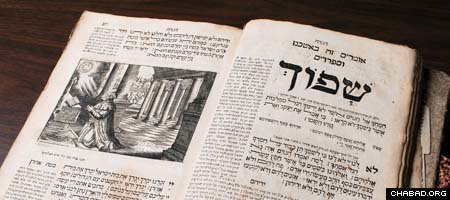The central Chabad-Lubavitch library in New York made 1,000 Passover Haggadahs, many of them rare, available on the Internet for browsing by the public. The Agudas Chasidei Chabad Library has one of the largest collections of the Passover orders of service in the world.
Housed at the Lubavitch World Headquarter, the library's Haggadah collection began years ago with a nucleus of some 400 volumes purchased on behalf of the Sixth Lubavitcher Rebbe, Rabbi Yosef Yitzchak Schneersohn, of righteous memory, by renowned collector and bibliographer Shmuel Wiener in 1924.
The posting at ChabadLibraryBooks.com represents close to half of the library's total Haggadah collection and is part of chief librarian Rabbi Sholom Ber Levine's goal of making the library more accessible to the public. All told, the library possesses more than 2,200 editions of the Haggadah. Although the rarest of the books, all handwritten, are not yet available, Levine is looking for ways to post them next year. Hebrew Books, directed by Chaim Rosenberg, collaborated on the project.
Those available online offer a snapshot of Jewish publishing history from the Middle Ages to the modern era. The oldest was printed in Berlin in 1527, while the most recent Haggadah was published in 1960 in Tel Aviv.
For years, researchers have flocked to the Lubavitch library in search of rare books and manuscripts. Avraham Yari, the first individual to catalogue Haggadahs following the Holocaust, consulted the institution in the 1950s and documented 32 Haggadahs whose only copy exists in the library.
"There are some very important Haggadahs in the Chabad library," said researcher Yitzhak Yudlov of the Jewish National Library in Jerusalem, who worked closely with assistant librarian Rabbi Yitzchak Wilhelm to produce the most current bibliography of Haggadahs. "There are Haggadahs that are not found elsewhere."
The text of the standard Haggadah was compiled by unknown sages centuries ago; it recounts the birth of the Jewish nation and Exodus from Egypt as recounted in the Torah. It also contains a section of prayers, with slight variations among different traditions, and is one of the most popular Jewish texts, having been reprinted in more than 7,000 editions throughout the years.
"The Haggadah's uniqueness is that one could find one that relates to every individual," explained Yudlov. "There are some with explanations, with pictures and for children. Passover is a happy holiday that all families want to take a part in."
Rabbi Hirsh Chitrik donated the funds for the online library in memory of his father, Rabbi Yehuda Chitrik, a scholar who spent most of his life studying Jewish texts. Chitrik said that the family's personal collection of Haggadah's brought a particular joy to his father.
"He would enjoy researching these Haggadas, concentrating on textual variations and the diverse customs of [his] various Jewish communities," said Chitrik.
A Unique Haggadah Collection

The online collection gives a virtual tour of the Jewish Diaspora throughout the generations. Haggadahs printed in the 1800's in Zhitomer, Ukraine; Königsberg, Germany; Prague; Vienna; London; Paris; Jerusalem; Biłgoraj, Poland; and New York track the movement and growth of Jewish communities across the world. Translations of the Haggadah in Arabic, Dutch, English, French, German, Hungarian, Italian, Ladino, Persian, Russian and Yiddish attest to the lingual integration of Jews into societies spanning the globe.
Workers at the library scanned the Haggadahs with special scanners that turned the pages with suctioned tips, thus minimizing any damage.
Among the rarest of the volumes available online is one of two different versions of one Haggadah compiled by Rabbi Jacob Lorberbaum, known as Yakov ben Yakov Moshe of Lissa, and produced on the same printing press in 1828. The other version sits in Jersualem. Each one, titled Maaseh Nissim, inexplicably features different typesets, Yudlov noted in his bibliography.
"There could be many reasons why," offered Wilhelm.
But with his bifocals perched atop his forehead, the librarian excitedly described the possibilities the online Haggadah project offers researchers looking into the Lorberbaum conundrum and other questions. Researchers working in Jerusalem can now print out the New York version and compare it to theirs to help give an explanation.
"Typesetting in those times is not what it is today," he said. "There is no doubt in my mind that there has to have been a good reason for the changes."
The online collection also features a Haggadah and commentary penned by the Rebbe, Rabbi Menachem Mendel Schneerson, of righteous memory. Dating from his early scholarly works published in pamphlet form in 1946, it amounts to more than 1,000 pages.
The rarest Haggadahs include one printed in 1853 by Tzvi Yakov Bamburg in Rodelheim, Germany, and featuring a translation and annotations in German; an 1883 order of service for the first two nights of Passover with an English translation published by H. Salkoski in New York; and an edition printed by Abraham Moshe Luntz in Jerusalem in 1901.
Among those not yet available online is the Breish Galei Haggadah prepared for print during the reign of Russia's last czar, Nicholas II, in 1911. A censor stamped the Haggadah on its cover, but it was never actually published. The world's only known copy made its way to the Lubavitch library when Communist authorities sold mounds of books for paper recycling to Wiener.









Start a Discussion